BLOG
The Ultimate Guide to Knowledge Management: 10 Strategies to Capture Tribal Knowledge
Learn how to capture and share critical tribal knowledge with 10 proven strategies to strengthen your organization’s collective intelligence and resilience.
Comparing Business Management Systems and the Human Body
Comparing a business management system (BMS) to the systems in the human body is a great way to bring some clarity to an otherwise confusing concept. The BMS vs. Body analogy also highlights how essential coordination and specialization are for effective operation. Here are a few ways to compare the two systems that may help you better promote a systemic approach in your organization.
What Is A Business Management Systems?
Think of a business management system (BMS) as the body of how an organization operates, aligns with customer needs, provides value, grows and changes. It’s not just one thing - it’s a carefully orchestrated mix of processes, people, policies, and information designed to meet your company’s goals, while adapting to an ever-changing world.
Bring Training & Certification In-House
We've been cooking up something really awesome in 2024! Did you know you could be scaling your training and employee development dollars 10x+ by bringing mobile-friendly certification courses in-house? Meet your workforce development where they are - on their mobile phones and tablets. Send us a text if you want to learn more.
Introducing the Super Turtle Diagram
This editable bundle contains various templates, examples and instructions that are simple to understand and configure yourself. Included are the Turtle Diagram template, the Swimlane Diagram, the SIPOC Diagram, the Tu-Poc Diagram and the new Super Turtle Diagram. Additional templates are added to illustrate how process teams can use these diagrams to analyze risks, the effect of changes on process outputs, resources needed to achieve desired results, process oriented metrics, and more.
SIPOC Diagrams VS Turtle Diagrams
The SIPOC diagram stands for Supplier Input Process Output Customer. Like the turtle diagram, the SIPOC is a schematic representation of the elements of a single process - starting with the supplier and ending with the customer.
Turtle Diagrams
A "Turtle Diagram" is a quality tool used to visually display process characteristics such as inputs, outputs (expectations), criteria (metrics) and other high-level information to assist in the effective execution and improvement of key business processes.
14 Ways to Continuously Improve Through ISO 9001 & Other Standards
Compliance management and continuous improvement does not have to be miserable work. Imagine having a friendly and knowledgeable expert by your side to guide you through your journey. That's what our ongoing support is all about. From the initial stages of formulating how to make your business more systematic, through certification and beyond, you can count on us to support your quest to get to the next level. Regardless of where you are today. And believe it or not, we will likely have a little bit of fun along the way. Seriously.
The Power of Custom Courses
In today's competitive business landscape, staying ahead of the curve and continuously improving operations is vital for success. Every business leader aspires to help their organization be more efficient, productive, and adaptable. One way to achieve these goals at scale is through custom course development. This blog explores how custom course development can be a game-changer for business operational improvement.
ISO 13485 QMS for the Medical Device Industry
In 2020, the global medical devices market size was valued at $512.29 billion USD. This market is projected to grow from $536.12 billion in 2023 to $800 billion by 2030 according to Forbes Business Insights (June 2023).




















